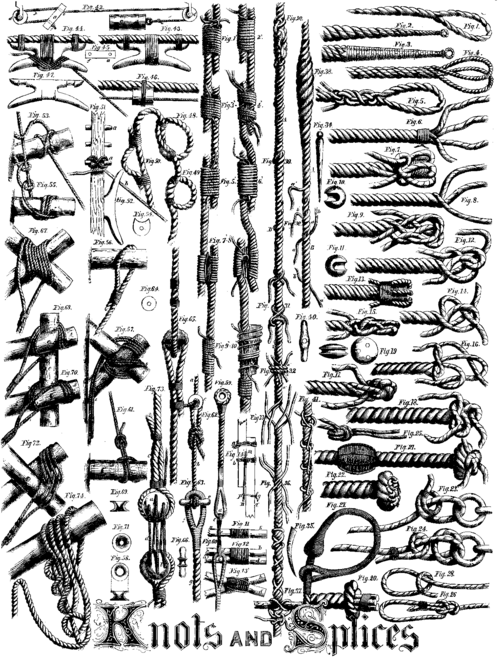
1. Turn used in making up ropes.
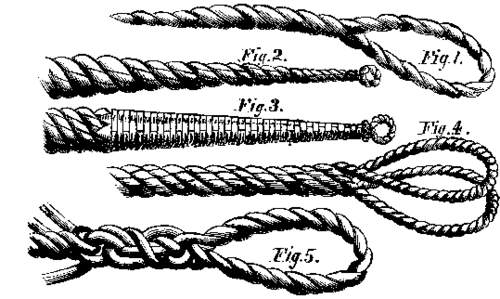
2. End tapered for the purpose of passing it readily through a loop. To make this, we unlay the rope for the necessary length, reducing a rope diminishing in diameter towards the end, which is finished by interlacing the ends without cutting them, as it would weaken the work; it is lastly "whipped" with small twine.
3. Tapered end, covered with interlaced cordage for the purpose of making it stronger. This is done with very small twine attached at one end to the small eye, and at the other to the strands of the rope, thus making a strong "webbing" around the end.
4. Double turn used for making rope.
5. Eye splice. The strands of the cable are brought back over themselves, and interlaced with their original turns, as in a splice.
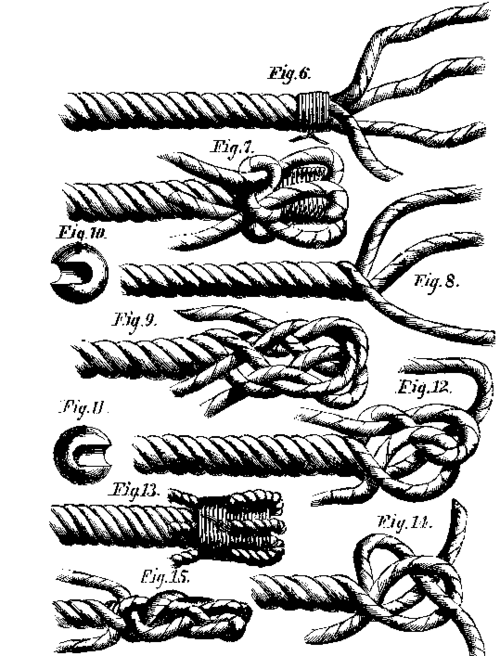
6. Tie for the end of a four-strand rope.
7. The same completed; the strands are tied together, forming loops, laying one over the other.
8. Commencement for making the end by interlacing the strands.
9. Interlacing complete, but not fastened.
10 and 11. Shell in two views used in No. 65, showing the disposition of it at the throat. This joining is advantageous, as it does not strain the cords, and it prevents them from cutting each other; so that the rings pass one into the other and are joined outside the intermediate shell.
12. Interlacing in two directions.
13. Mode of finishing the end by several turns of the twine continued over the cable.
14. Interlacing commenced, in one direction.
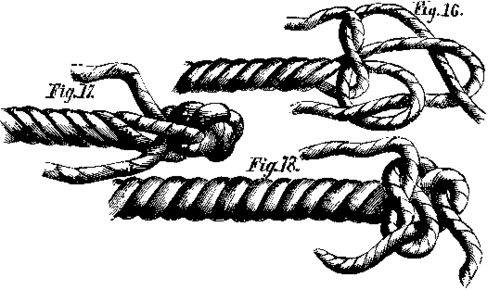
15. Interlacing finished, the ends being worked under the strands, as in a splice.
16. Pigtail commenced.
17. Interlacing fastened.
18. Pigtail with the strands taut.

19. Dead eye, shown in two views.
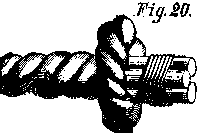
20. Pigtail finished. We pass the ends of the strands, one under the other, in the same way as if we were making a pudding splice: thus bringing it in a line with the rope, to which it is seized fast, and the ends cut off.

21. Scull pigtail; instead of holding the ends by a tie, we interlace them again, as in No. 16, the one under the other.
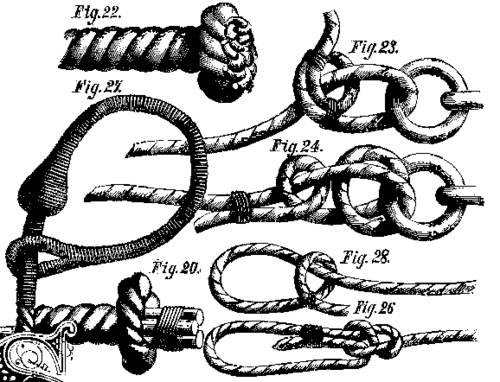
22. Pigtail, or "lark's nest." We make this to the "pennant" of a cable, which has several strands, by taking the requisite number of turns over the pudding, in such a manner that the strands shall lay under each other. This "pigtail" forms a knot at the end of the rope. It thus draws together two ropes, as shown in No. 32, forming a "shroud" knot. In these two pigtails, the strands are crossed before finishing the ends, so that the button, a, is made with the strands, a, and b, with those of the rope, b.
23. Slip clinch to sailors' knot.
24. Slip clinch, secured.

25. Ordinary knot upon a double rope.
26. Bowline knot for a man to sit in at his work.
27. Called a "short splice," as it is not of great length, and besides, can be made quickly.

30. Long splice. This extends from a to b. We unlay the strands of each of the ropes we intend to join, for about half the length that the splice will be, putting each strand of the one between two strands of the other.
31. Simple fastening on a rope.
32. A "shroud" knot.
33. The ends of the rope are prepared for making the splice (No. 29) in the same manner as for the "shroud" knot in No. 32. When the strands are untwisted, we put the ends of two cords together as close as possible, and place the ends of the one between the strands of the other, above and below alternately, so as to interlace them as in No. 29. This splice is not, however, very strong, and is only used when there is not time to make a long splice, which is much the best.
34 and 35. Marline spikes. Tools made of wood or iron, used to open out a rope to pass the strands of another through it.
36. Shows strands arranged as described in No. 30.
37. Fastening when a lever is used, and is employed when hauling upon large ropes, where the strength of several men are necessary.
38. A "pudding splice." This is commenced, like the others, by placing the rope end to end, the turns of the one being passed between those of the other; having first swelled out the yarns by a "rat's-tail," we put them, two by two, one over the other, twisting them tightly, and opening a way for them with the marlinspike. The inconvenience of this splice is, that it is larger in diameter than the rope itself; but when made sufficiently long, by gradually reducing the size of the strands, it has great strength.
39. This shows two strands, a and b, of the ropes, A B, knotted together, being drawn as tight as possible; we unlay the strand, a', of the rope, A, for half the length of the splice, and twist the strand, b', of the rope, B, strongly in its place, tying a' and b' together tightly. The same process is again gone through on the rope, B, the strand, a", of the rope, A, being knotted to the strand, b", of the rope, B. When all the strands are thus knotted together, we interlace them with the strands of the cable. Thus the strands, a a' a", are interlocked by being passed alternately above and below the turns of the cord, B, the ends being also sometimes "whipped." In the same manner the strands, b b' b", pass alternately over and under the strands of the rope, A, and are in like manner "whipped." It is important that the several interlacings and knots should not meet at one point; we reduce the size of the strands towards the end, so that they loose themselves in the body of the splice, cutting off such parts as may project. This splice is employed for joining the ends of a rope when a chafed part has been cut out, and is quite as strong as the rope itself.